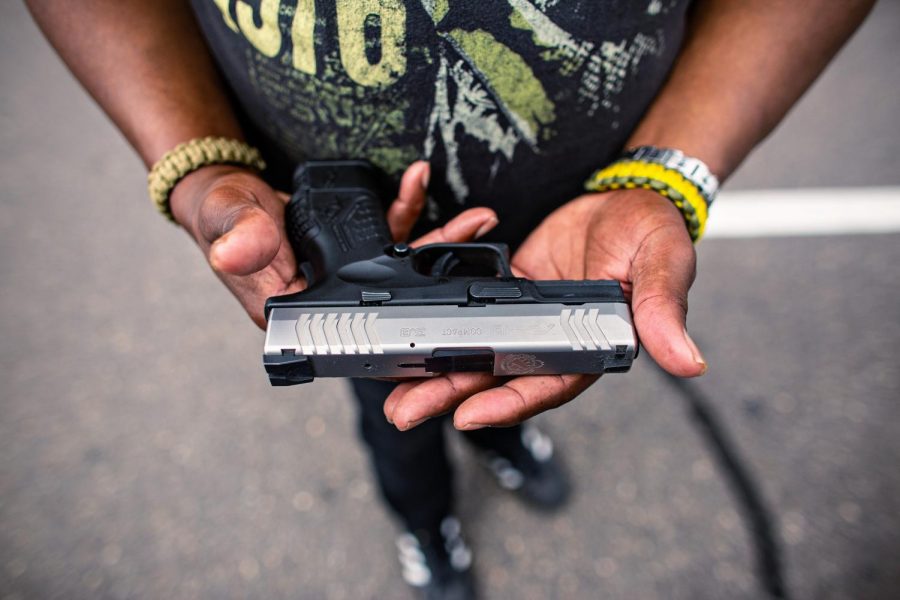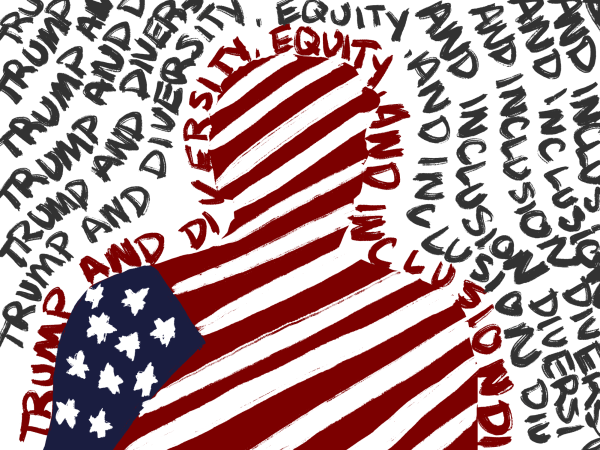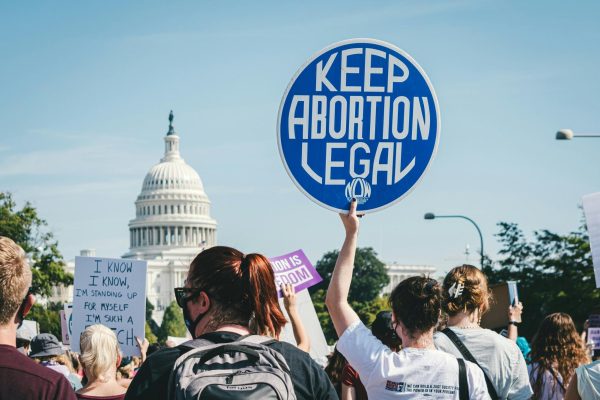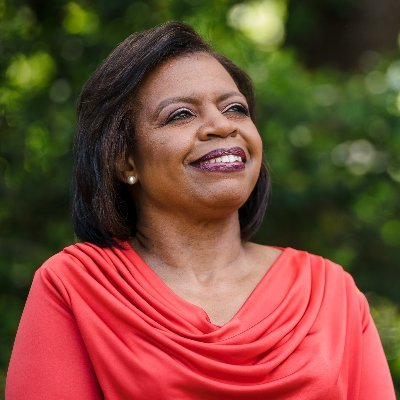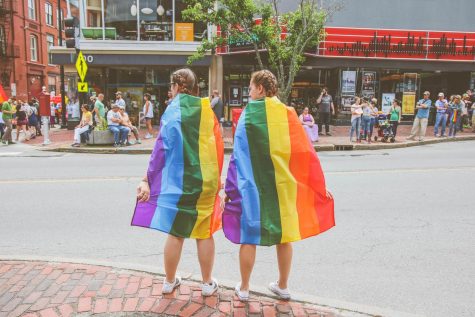OPINION: America needs tougher gun laws, but don’t freak out, gun supporters.
MINNEAPOLIS, MN – JULY 25: Reverend Tim Christopher, hold his firearm that he always carries while attending the meet-and-greet event held Minnesota Freedom Fighters on Saturday, July 25, 2020 in Minneapolis, MN. Christopher has testified before the MN House Judiciary Committee on gun control legislation. (Jason Armond/Los Angeles Times/TNS)
Coronavirus, racism and police brutality are the issues most likely to decide the 2020 election. But there’s another topic that is being discussed surprisingly little—guns. Amid pandemic-induced shutdowns, mass shootings and school shootings have temporarily faded from national headlines (Breathes a deep sigh of relief). In fact, April 2020 was the first month in decades without some sort of gunfire on American school grounds.
At some point, though, social distancing has to end and people have to gather in large groups again. These large gatherings, including crowded shopping centers, educational institutions and entertainment venues are mass shooters’ prime targets. In the meantime, excessive time in isolation will likely lead to increased self-radicalization of extremist groups, a major warning sign of a potential killer. These strengthened extremist groups, combined with mass protests, riots, and a tight presidential election can create a recipe for disaster.
Mass shootings, of course, are only the tip of the iceberg. The majority of firearm-related deaths in the U.S. are suicides, a second health crisis only exacerbated by the pandemic. Homicides, most of which are targeted and not random, come in second. According to the Pew Research Center, active shooter incidents–random shootings in populated areas that do not include domestic or gang-related mass shootings–only killed 85 people in 2018. However, the U.S. witnessed 23,854 suicides and 14,542 murders, respectively, with guns in 2017.
A disproportionate number of these deaths involve impoverished, minority groups, most notably inner-city African-Americans. These communities not only face a greater prevalence of crime but also mental health conditions. Brookings University found that from 2011 through 2013, the rate of gun deaths for Black men (34 per 100K) doubled that of White men (17 per 100K). For men in the 20 through 29 age cohort, the rates were higher for men of both races but were four-and-a-half times higher for African-Americans than for white people. People of color who die of gun violence are also much more likely to die by homicide than by suicide, and while suicide is still quite concerning, it is somewhat easier to prevent than crime and homicide.
Furthermore, the U.S. has the most guns per capita, at roughly 120 per 100 people. The country is the only one to house more firearms than humans. Additionally, it has the most gun homicides per capita, 29.7 per million people, beating out Switzerland, the runner-up, by fourfold. But murders aren’t the full story: according to Giffords Law Center, 51 percent of U.S. suicides involve a firearm, and access to such weapons triples the risk. There may even be a scientific link between the mere presence of guns and aggressive, antisocial behavior. And unfortunately, all this means that just the ubiquity of guns in the U.S. is probably driving up preventable injuries and deaths (and exorbitant medical costs).
Gun violence is a grave problem even when it isn’t making national headlines. In between all the high-profile massacres, thousands of young African-Americans are being quietly yet brutally slaughtered in our inner cities. In addition to murders, suicide is another devastating result of the lack of gun control in the United States. Those who are unable to access quality mental health care, sometimes turn their weapons on themselves as a final solution. The United States has the responsibility to protect its people from harm. Creating measures to protect citizens from gun violence is the first step in solving the problem we’ve been plagued with for decades. Unfortunately, our federal government has been unable to pass any significant changes in recent years. So the question worth asking is, how do we enact change and strike a balance between saving lives and protecting Second Amendment rights?
Let’s analyze defensive gun use in the U.S., which is very loosely defined. The CDC considers any “use of a firearm to protect and defend one’s self, family, others and/or property against crime or victimization” to be defensive gun use. The agency estimates that there are anywhere from 60,000 to 2.5 million cases of it annually.
However, a pro-gun control article from the Washington Post, takes a much more rigid stance. It only counts incidents in which an attacker is shot. To further build its case against firearm ownership, it cherry-picks a few episodes of illegal or mistaken self-defense leading to wrongful injury or death. There is a huge problem with this position: most cases of self-defense involve no shots being fired. A 1994 study by the CDC found that American homeowners successfully used firearms against home invasions 503,841 times, but the intruders were merely scared off, without the victims firing their weapons, in 95 percent of these cases.
In the context of mass shootings, which are a main impetus for civilians to carry in public, police usually take minutes to arrive on scene. The actions of the people in the kill zone are what will decide the toll of an event. Running and hiding–and not fighting unless absolutely necessary–are the best ways to stay safe. But if anyone besides the killer has a gun, they can end the incident right away and save many lives. Late last year, a gunman opened fire in a Texas church, but one of the congregants was armed and took down the shooter, who only shot two people out of more than 200 attendees.
Despite the strong evidence supporting defensive gun use, many gun-control advocates argue that if guns were banned or severely restricted, there would be no need for it. But there’s a big problem with that logic: criminals do not obey the law. Due to modern-day international trade and the Internet, the bad guys can traffic firearms from overseas or order them off the Dark Web. A particularly egregious case was the Nov. 2015 parade of ISIS-orchestrated mass shootings in France, a country that imposes tight curbs on arms.
Perhaps the biggest reason to steer clear of gun control is the potential for government overreach and abuse. Following their victory against the British, the Founding Fathers created the U.S. on the principles of small government. Thomas Jefferson famously believed that those in charge should be our servants, not our masters. One hundred fifty years later, during World War II, the severe checks on government may have prevented the U.S. from turning into a dictatorship unlike nations like Spain, Italy, Japan and of course Nazi Germany.
The latter country stands out and is worth further discussion. In the years before the war, Hitler revoked firearm rights, but only for the Jews. The new rules eliminated practically all of the Jews’ ability to fight back and resist, and by the end of the war six million of them tragically perished. Sure, there were uprisings, but they were small and the government was able to eventually suppress them. The most shocking finding is that in 1900, Germany was a relatively free country that respected its Jewish population. But the world was very unstable then and rapidly deteriorated from there, exploding into world war, economic turmoil and tyranny. A similar situation is playing out in the U.S., with growing instability, partisan divide and President Donald Trump’s nationalist, anti-globalization and anti-Muslim policies. Our government clearly needs to be kept in check and prevented from imposing overarching gun-control policies.
The issue of gun rights is clearly a very complex one, and we have discussed very strong reasons for agreeing with either side of the argument. However, the most effective option does not involve making a rigid choice. Instead, we need small-scale interventions, most notably red-flag laws to separate those at risk of harming themselves or others from their weapons. The ultra-libertarian fears of abuse and lack of due process would be laid to rest as seizures would only be temporary, and subjects would remain entitled to speedy hearings following seizures.
Furthermore, other gun violence, like that of inner cities, could be curbed via stronger registration and tracking regulations as well as community-based initiatives already in use for general crime prevention. Democrat Joe Biden, leans more toward the side of control. Fortunately, his planned tactics are lighter than those of his rivals, some of whom have considered full-scale mandatory buybacks of certain types of guns. They mainly include red-flag laws, universal background checks, and safe-storage laws to prevent weapons from unintentionally ending up in the wrong hands, with a particular focus on those dangerous inner-city districts. These softer measures could help solve the gun puzzle without resorting to collective punishment against legal gun owners, the vast majority of whom will never hurt anyone, or giving the government more power than necessary.


